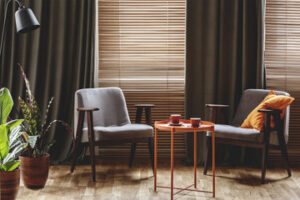Blinds and Shades are window treatments that provide light control, privacy and style to a room. Blinds have a hard material construction and are typically easier to clean, though they can be susceptible to staining over time.
Shades are typically made from softer materials and come in a wide variety of colors, patterns and textures that pair well with different interior decor styles. Visit https://www.customblindsandshadesky.com/ to learn more.

Unlike draperies, blinds are composed of horizontal or vertical slats that can be adjusted to control the amount of light in a room. They’re an affordable window treatment option for any space and are available in a wide range of colors and materials, though the type you choose will ultimately depend on how you plan to use the room.
Blinds are often more practical than shades, especially for high traffic areas. They can easily be cleaned by a simple dusting or vacuuming, though tough stains may require professional cleaning. Additionally, blinds are more affordable than many other window treatments and can be paired with decorative cornices, fascias and valances to add even more style and sophistication.
Shades, on the other hand, are typically made from a more delicate natural fabric and work best in low-moisture settings. Woven wood shades, for example, are created from bamboo, reeds and grass fibers and can add organic color to any room. However, they don’t provide as much privacy or light control compared to other shade types and work best in a dining, living or bedroom area.
Both blinds and shades come in a variety of styles, materials and prices. One consideration to keep in mind is whether you want a corded or cordless design. Cords can be dangerous for small children and pets, so Bloomin’ Blinds offers a number of cordless options that are safe for all family members.
Both shades and blinds are available in a broad array of fabrics, with each fabric serving its own specific function. For instance, translucent or room-dimming shades in lighter colors allow a lot of natural light to enter a space while still providing privacy. On the other hand, dark shades with minimal light transmittance can be used as a blackout window covering. Other fabric options include cellular shades, which are the most energy-efficient, and transitional zebra shades, featuring alternating strips of solid and sheer fabrics.
Design
While they may be similar in appearance, blinds and shades differ in design and functionality. Blinds are “hard” window coverings that include a set of slats (also called louvers) that can be adjusted to direct sunlight, limit view or even block it completely. They can be crafted from wood, faux-wood, metal or other materials and come in a variety of styles like horizontal blinds, vertical blinds, cellular shade and woven bamboo. Some blinds can also be made into smart blinds that can connect to a hub and control via voice commands or a remote.
When it comes to light control, blinds offer the best options for filtering natural light into a room. Their slatted construction allows you to control where light falls, and some models can be tilted open for a partial view or closed to block the sun entirely. Shades, on the other hand, are better suited for diffusing light or darkening a room altogether. Roller shades, cellular shades and roman shades can be used to create a soft glow while maintaining privacy, and they’re often designed with an insulating fabric that helps regulate room temperature and reduce energy usage.
Blinds are also more durable than shades and can withstand repeated use for a longer lifespan than fabric. Their hard surface makes them easy to wipe down and keep clean, though slats can get dirty over time with dust or grime that collects. Some blinds can be treated with a factory-applied antistatic finish to prevent this issue. They’re also easier to install, with inside-mount and outside-mount options available for a more streamlined look.
Light Control
Blinds offer a distinctive aesthetic that can elevate the look of any room. Their slatted design offers easy light control, with the option to tilt their slats to direct how much natural light enters a space or shut them completely for privacy. Blinds also come in a variety of materials that can complement different interior decor styles.
Shades, on the other hand, are more versatile and can be designed with a wide range of fabrics, colors, patterns, and textures. They can be rolled up on a tube (Roller shades), folded up into an accordion style (Roman shades) or pushed up in a pleated fashion (Pleated and Cellular shades). With such a diverse array of options, blinds and shades can blend seamlessly with different aesthetic styles.
Traditionally, both blinds and shades are operated via cords. However, there are now a variety of cordless or motorized options available, which reduce the risk of strangulation and make them the safest choice for homes with young children.
Both blinds and shades can be fitted with a variety of upgrades, such as decorative tapes, slat sizes, and color upgrades. They can also be installed as inside-mount or outside-mount window treatments.
Blinds are typically made from rigid materials, which means they can withstand more wear and tear than shades, and are more resistant to moisture. They’re also easier to clean, with the ability to wipe them down or dust them easily. Shades, on the other hand, can be prone to staining or fading over time. They may also require more frequent vacuuming or washing, depending on their fabric.
Energy Efficiency
With warmer temperatures and more sunshine, many homeowners are busy working on home improvement projects. Window treatments are one of the most impactful improvements you can make to your home’s aesthetic and can help lower your energy bills. With different options and considerations, it’s important to choose the right type of window treatment to ensure you’re getting the best value for your money.
Blinds and shades both have their own distinct aesthetics that complement various interior decor styles. Blinds offer a sleek and modern look with their slatted design, and they come in a variety of materials that can blend seamlessly into your space.
Shades are more flexible in their light control, allowing you to tilt their fabric and direct how much light enters your space. They’re also available in a variety of colors and textures, giving you a wide range of options to fit your aesthetic preferences. Additionally, shades can be layered with other window treatments to add a custom and functional aesthetic.
Both blinds and shades provide varying levels of insulation, depending on their construction and materials. The most efficient types of shades are cellular and honeycomb shades, which use little pockets of air to prevent heat from entering or leaving your space.
Blinds typically require less maintenance than shades, as they’re made from hard materials that are more resistant to wear and tear. Shades, however, can be more prone to staining and might need to be vacuumed or spot cleaned on occasion. They’re also more likely to feature cords, which can pose a safety risk for households with young children. Fortunately, most shades are now offered with cordless and motorized options to avoid this issue altogether.
Privacy
Blinds offer a solid baseline of privacy for your home. Their slatted design helps create a sophisticated aesthetic and they’re available in many materials that can match or complement various decor styles. When open, they obscure the view from outside your window. They’re also relatively easy to clean. With a simple wipe, they’ll stay looking like new – though hard-wearing or textured fabrics might require more frequent cleaning. Blinds are less likely to fade or stain than shades, though they can be susceptible to stains and dirt from high-traffic areas or from kids and pets.
Shades can be more difficult to see through, depending on the fabric they’re made from and how opaque or light filtering the material is. This makes them a great choice for bedrooms where you’re looking for a bit more darkness during the day or living rooms where you want soft natural light.
Some shades also come with a smart feature that allows you to control them with your voice or a compatible smart home hub. This is particularly important if you have children and want to ensure that they don’t accidentally adjust or pull down your shades.
Whether you prefer the look of blinds or shades is entirely up to you. Both options can be beautiful and effective in any space, but your specific needs and preferences will guide your selection process. Make sure you take the right measurements and carefully consider your style options before investing in any new window treatments. By taking the time to choose a style that best matches your home, you’ll ensure they’re both attractive and functional. To get started, browse our online shop for inspiration and find the perfect set of blinds or shades to fit your space.
